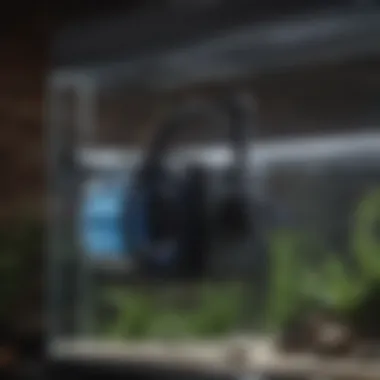Top UV Sterilizers for Healthy Aquariums


Intro
In the context of aquarium maintenance, UV sterilizers serve as a crucial mechanism for sustaining aquatic life. These devices effectively eliminate harmful microorganisms from water, improving clarity and promoting overall health in the aquarium environment. While often overlooked, understanding the best UV sterilizers can have profound implications not just for aesthetic appeal but for the biological stability of your aquarium.
This article will provide a comprehensive analysis encompassing several key aspects. We will explore how UV sterilizers function, evaluate various models suited for differing aquarium setups, discuss maintenance practices, and debunk common myths surrounding their usage. The aim here is to furnish both novice and seasoned aquarium enthusiasts with the essential knowledge required to optimize their aquatic habitats.
To make the information more digestible, the guide unfolds through several vital sections. Each will dissect pertinent details regarding the functionality and impact of UV sterilizers, allowing readers to make informed decisions. By concentrating the discussion on tangible recommendations and clarifying misconceptions, we seek to enhance your understanding and practical application of UV sterilization in aquaria.
Intro to UV Sterilizers
Understanding UV sterilizers is crucial for any aquarium owner seeking to maintain a healthy aquatic environment. These devices serve a specific function that is often not fully appreciated. Their role extends beyond merely aesthetic improvements in water clarity; they are essential tools in the broader discourse of aquatic health management.
Definition of UV Sterilizers
UV sterilizers are devices designed to eliminate harmful microorganisms from aquarium water using ultraviolet light. The mechanism operates by emitting UV-C light, which disrupts the DNA and RNA of pathogens. This disruption prevents their ability to reproduce and hence leads to the eventual die-off of unwanted microorganisms in the water. Notably, UV sterilizers can effectively address issues such as algae blooms, bacterial infections, and even certain viruses.
Importance of UV Sterilization in Aquariums
The importance of incorporating UV sterilizers into aquariums cannot be overstated. These devices provide several key benefits that foster healthier environments for aquatic life.
- Pathogen Control: UV sterilizers dramatically reduce disease outbreaks by controlling populations of harmful pathogens such as bacteria or parasites. This is vital for both fish and plant health.
- Algae Management: They help in controlling excessive algae growth, which can lead to murky water and poor conditions for fish.
- Enhancing Water Quality: Besides pathogen control, UV sterilization improves overall water quality, which benefits all marine inhabitants.
- Preventative Maintenance: Regular use of a UV sterilizer can be part of a preventive maintenance routine, thereby reducing the necessity for reactive measures to biological crises.
"Integrating UV sterilizers into your aquarium setup lays down a foundation of safety, promoting not just the aesthetic but the biological balance within the ecosystem."
Considering these facets, it becomes clear why understanding and implementing UV sterilization is pivotal to successful aquarium management.
How UV Sterilizers Function
Understanding how UV sterilizers function is crucial for aquarium owners who seek to maintain a healthy aquatic environment. These devices are not just accessories; they serve as vital tools in ensuring the well-being of fish and other aquatic life. By harnessing the power of ultraviolet (UV) light, these sterilizers effectively target and eliminate a variety of harmful microorganisms. This section will delve into the science behind UV light and discuss the specific pathogen elimination processes that these devices employ.
The Science Behind UV Light
UV light is a type of electromagnetic radiation that falls between visible light and X-rays in the electromagnetic spectrum. It is further divided into three categories: UVA, UVB, and UVC. Among these, UVC light is the most effective for sterilization purposes. This is because UVC light can penetrate the cell walls of microorganisms, leading to the destruction of their DNA. As a result, these pathogens are either rendered inactive or destroyed, preventing them from reproducing.
To ensure optimal results, the intensity and exposure time of the UV light are essential factors. Typically, a UV sterilizer will have a quartz sleeve that protects the UV bulb while allowing the light to pass through. This design ensures that water can be treated as it flows through the sterilizer, exposing any pathogens present to the lethal UVC light. The overall effectiveness of UV sterilizers hinges on the correct specification of bulb strength and flow rate.
Pathogen Elimination Process
The process of eliminating pathogens in aquariums using UV sterilizers involves a continuous flow of water through the unit. Here's how the process usually works:
- Water Inflow: Water from the aquarium is pumped into the UV sterilizer.
- Exposure to UV Light: As the water travels through the chamber, it is exposed to UVC light. The wavelength of this light is particularly harmful to bacteria, viruses, and algae.
- Disruption of Pathogens: The UVC light disrupts the DNA of these microorganisms, either killing them outright or making them incapable of reproduction.
- Water Outflow: Finally, the sterilized water is returned to the aquarium, contributing to a healthier environment.
"The continuous flow and exposure to UVC light in UV sterilizers are crucial for maintaining an engaging aquarium ecosystem, minimizing the risk of disease outbreaks."
The entire cycle not only aids in controlling harmful microorganisms but also helps in maintaining clear water—a key indicator of a healthy aquarium. Thus, understanding these processes empowers aquarium owners to make informed choices about using UV sterilizers effectively.
Benefits of Using a UV Sterilizer
UV sterilizers play a vital role in maintaining the overall health of aquariums. Their operation is not only simple but effective in preventing various issues that can arise in aquatic environments. In this section, we will delve into the specific benefits of using a UV sterilizer, providing a clearer perspective on why aquarium enthusiasts should consider integrating this technology into their setups.


Improved Water Clarity
One of the most immediate benefits of a UV sterilizer is improved water clarity. When water clarity is optimal, it enhances the visual aspect of the aquarium. UV sterilizers help in clarifying the water by targeting free-floating algae cells that often cloud the water, providing a cleaner and more pleasant environment. Additionally, clearer water allows for better light penetration, which can further benefit aquatic plants and fish. Improved clarity also means that observation of aquatic life becomes more enjoyable, allowing for a more engaging experience for the owner.
Reduction of Harmful Pathogens
Another significant advantage of UV sterilizers is their effectiveness in reducing harmful pathogens. In aquariums, pathogens such as bacteria and parasites can proliferate quickly, causing diseases that can spread rapidly among fish. UV sterilizers work by exposing these microorganisms to ultraviolet light, effectively destroying their genetic material. This results in a substantial reduction of potential diseases that could harm the fish. The proactive approach in preventing outbreaks is crucial for the well-being of the aquatic ecosystem.
"By utilizing a UV sterilizer, aquarium owners can establish a safer aquatic environment and protect their fish from potential health threats."
Enhanced Fish Health
With the dual benefits of improved water clarity and the reduction of harmful pathogens, enhanced fish health is a natural progression. When fish live in a cleaner environment with fewer pathogens, their overall stress levels decrease. This, in turn, strengthens their immune systems, leading to healthier and more vibrant fish. Healthy fish not only exhibit better coloration but also display more active and natural behaviors. Regular use of a UV sterilizer encourages a thriving aquatic environment, which is beneficial for both novice and experienced hobbyists.
In summary, integrating a UV sterilizer into an aquarium can lead to significant improvements in water clarity, aid in the reduction of harmful pathogens, and promote enhanced fish health. These benefits ensure that both the aquatic environment and its inhabitants flourish.
Selecting the Best UV Sterilizer
Evaluating and choosing the right UV sterilizer is essential for ensuring optimal aquatic health in your aquarium. The selection process involves several specific factors that can significantly affect the device's effectiveness and efficiency. Understanding these elements can aid aquarists in making informed decisions that align with their particular situations.
Considerations for Size and Capacity
When selecting a UV sterilizer, size and capacity ought to be top priorities. The capacity of the UV sterilizer generally refers to the volume of water it can effectively treat within a given timeframe. It is crucial because different aquarium setups have varying water volumes, which will directly influence the effectiveness of the sterilizer.
Many models come with specifications indicating the maximum tank size they can accommodate. For example, a sterilizer might state that it is effective for tanks up to 200 gallons. If your tank exceeds this volume, consider purchasing a larger unit or multiple units to ensure proper treatment. Generally, matching the sterilizer's capacity with your aquarium size will help prevent issues such as leaks or short-circuited filtering, leading to diminished effectiveness.
Flow Rate and Efficiency
The flow rate of a UV sterilizer is another significant consideration. This refers to how quickly water passes through the sterilizer, measured in gallons per hour (GPH). A higher flow rate means water can be cycled through the sterilizer more quickly, but this often means it has less time for the UV light to effectively neutralize microorganisms. Thus, finding a balance between flow rate and treatment time is essential.
Opt for a UV sterilizer whose flow rate is suitable for your aquarium's water volume and the type of microorganisms you aim to eliminate. If your tank has a high bioload or issues with algae, you may require a model with a lower flow rate for extended contact time. It's recommended to consider adjusting the flow rate based on actual performance and aquarium needs.
Type of Aquarium Setup
The type of aquarium setup you have also plays a crucial role in choosing the right UV sterilizer. Different setups, whether freshwater, marine, or reef tanks, have unique requirements. For instance, reef tanks often contain corals and sensitive marine life that could be adversely affected by overly strong UV exposure. Therefore, selecting a sterilizer with lower intensity or adjustable settings may be necessary.
Moreover, you should assess whether you have a sump or external filtration system in place. Some UV sterilizers integrate seamlessly into these systems, while others are designed for stand-alone use. Taking the time to evaluate your specific aquarium setup will allow you to pick a sterilizer that not only fits your needs but operates efficiently within the established ecosystem.
Selecting the right UV sterilizer involves balancing size, capacity, flow rate, and your unique aquarium setup.
In summary, the process of selecting the best UV sterilizer is multifaceted and requires careful consideration of size, flow rate, and the aquarium's specific setup. Each element interacts with the others, influencing the overall effectiveness of the sterilization process. By methodically assessing these aspects, aquarists can enhance the health and clarity of their aquariums, ultimately leading to a thriving aquatic environment.
Top UV Sterilizers on the Market
Selecting a UV sterilizer for your aquarium is a crucial step toward ensuring a healthy aquatic environment. This segment reviews key products available on the market and outlines various factors to consider when making a choice. The importance of understanding the current landscape of UV sterilizers cannot be overstated. Given the variety of options and technologies, knowledgeable selection aids in achieving optimal water quality and enhances the overall health of the aquarium ecosystem.
Product Reviews and Comparisons
When evaluating UV sterilizers, it is essential to examine specific products. The following models have gained recognition for their efficiency and effectiveness:


- Aqua UV Classic 25 Watt: Known for its robust build and reliability. This sterilizer uses housing that is resistant to UV degradation, ensuring longevity.
- Coralife Turbo-Twist 36 Watt: This model boasts a unique twist design, enhancing UV exposure. It is particularly effective in larger tanks and is easy to clean and maintain.
- Penn Plax Cascade 9 Watt: This entry-level model is suitable for smaller aquariums. It provides commendable performance at a reasonable price point.
- Emperor Aquatics Smart UV 40 Watt: Designed for larger systems, this sterilizer features an efficient flow rate and is user-friendly, catering to both novices and experienced hobbyists.
When reviewing these products, consider aspects like wattage, flow rate, and design specificity. Comparing user feedback and performance can also provide insights into their real-world applicability. Reading reviews on platforms like reddit.com can be beneficial for observing unfiltered customer experiences.
Cost Considerations
The cost of UV sterilizers varies widely, depending on brand, size, and technology utilized. Initially, it may seem logical to choose the least expensive option. However, a more expensive sterilizer often reflects better materials and technology. Here are essential points to keep in mind:
- Initial Investment: Quality models typically range from $50 to over $300. Consider your aquarium size and the types of fish you keep when budgeting.
- Operating Costs: Some sterilizers have higher wattage and can result in increased electricity bills. While the upfront cost is important, consider overall operating costs when making your decision.
- Longevity and Maintenance Costs: Cheaper models may require frequent bulb replacements or repairs. Investing in a more durable model reduces the total cost of ownership over time.
Overall, the goal should be to balance initial expenditure with long-term benefits. In many cases, customers express satisfaction with the performance from investing a bit more for a reliable product.
"Investing in a quality UV sterilizer not only enhances the clarity of your water but also significantly contributes to the health of your aquatic life."
By understanding the various products and their respective costs more clearly, enthusiasts can make informed decisions that better serve their aquatic environments.
Common Misconceptions About UV Sterilizers
Understanding common misconceptions surrounding UV sterilizers is crucial for aquarium enthusiasts. Misunderstandings can lead to improper use or unrealistic expectations, affecting the health of the aquarium. This section addresses prevalent myths and beliefs, providing clarity about the role and operation of UV sterilizers in aquatic environments.
Myths Regarding Effectiveness
One of the most frequent myths about UV sterilizers is the belief that they can eliminate all types of pathogens instantly. Some aquarists assume that installing a UV sterilizer will instantly create a crystal-clear environment, eliminating any need for other filtration methods. While UV sterilizers effectively kill bacteria, viruses, and certain algae, they do not replace the need for mechanical and biological filtration systems. Moreover, UV effectiveness depends on several factors, such as water flow rate, exposure time, and the specifics of the pathogens involved.
For effective usage, it is necessary to choose a UV sterilizer that matches the size and flow of your aquarium. This ensures that the water passes through the sterilizer at an appropriate rate to achieve the desired effect. It is also important to remember that while UV sterilizers significantly reduce pathogen load, they may not completely eliminate them. Regular water quality monitoring and maintenance are still essential in keeping the aquarium healthy.
Beliefs About Maintenance
Another common belief is that UV sterilizers require little to no maintenance once installed. While it is true that UV sterilizers can operate with minimal user intervention, they are not maintenance-free. Regular cleaning and bulb replacement are necessary to ensure optimal performance.
Typically, the UV bulb should be changed at least once a year, as its effectiveness diminishes over time. Also, the quartz sleeve that houses the bulb can become dirty from algae and other debris, impairing the UV light’s effectiveness. Cleaning this sleeve routinely will help maintain the efficiency of the sterilizer.
Additionally, monitoring the performance of the UV sterilizer is critical. Observing changes in water clarity or the presence of algae may indicate a drop in performance, necessitating cleaning or bulb replacement. By understanding these maintenance requirements, aquarium owners can optimize the benefits of their UV sterilizers.
Maintenance and Care for UV Sterilizers
Maintaining and caring for UV sterilizers is crucial for the effectiveness and longevity of these devices in your aquarium ecosystem. Proper upkeep ensures that your UV sterilizer operates at its optimal levels, providing clean and clear water while eliminating harmful pathogens. Regular maintenance can prevent many common issues that arise due to neglect, which can lead to decreased efficiency or even complete failure of the unit. Understanding the best practices for maintenance will enhance both the performance of the sterilizer and the health of your aquatic environment.
Cleaning and Replacing Bulbs
A key aspect of maintaining a UV sterilizer is cleaning and replacing its bulbs. The UV bulbs are the core of the sterilization process, emitting light that kills bacteria, viruses, and algae. Over time, the bulbs lose their effectiveness and can become coated with debris, dirt, and slime. This buildup inhibits their ability to emit UV light efficiently.
- Cleaning the Bulb: Regular cleaning involves carefully removing the bulb from the unit and using a soft, damp cloth to wipe it down. It is important to avoid harsh chemicals that can damage the bulb or the sterilizer components.
- Replacing Bulbs: Most manufacturers recommend replacing UV bulbs every 6 to 12 months, regardless of usage, to ensure maximum efficiency. Note that many bulbs maintain their physical structure after this period but produce significantly less UV output.
"Regular maintenance not only ensures efficiency but also extends the lifespan of your sterilizer."
Monitoring Performance
Monitoring the performance of your UV sterilizer helps in identifying potential issues before they escalate. Regular checks can reveal if the device is functioning as intended or if adjustments are necessary.


- Visual Indicators: Many UV sterilizers have indicators that show whether the unit is operational. Check these regularly to confirm the workability of the device.
- Water Clarity: Observing the clarity of your aquarium water can be a direct measure of the sterilizer's effectiveness. If the water appears cloudy, it may indicate that the sterilizer needs cleaning or the bulb needs replacement.
- Flow Rate: Monitor the flow rate to ensure it remains consistent. A drop in flow may signal a blockage or malfunction within the sterilizer that requires immediate attention.
Incorporating these maintenance steps into your routine will greatly contribute to a healthier aquarium environment, fostering the well-being of aquatic life while ensuring that your UV sterilizer is a reliable tool in your aquarium care arsenal.
Potential Drawbacks of UV Sterilizers
While UV sterilizers serve an important role in aquarium health, they are not without their drawbacks. Understanding these limitations can help aquarium owners make informed choices and optimize their setups. This section will highlight essential considerations, including how these systems can affect filtration and beneficial bacterial growth.
Limitations in Filtration Systems
UV sterilizers are often incorporated into the existing filtration systems of aquariums. However, relying solely on a UV sterilizer for your aquarium's filteration process can be problematic. The efficacy of a UV sterilizer depends greatly on water flow rate. If the water moves too quickly, pathogens may not be exposed to the UV light long enough to be effectively killed. This means a UV sterilizer is an effective tool but not a standalone solution for maintaining water quality.
When integrated with other filtration methods, such as mechanical, chemical, or biological systems, a UV sterilizer should enhance the overall performance. It is essential to balance the flow rates and communication between devices. Using a UV sterilizer that matches the flow capacity of the filtration system you have can ensure optimal pathogen reduction.
Impact on Beneficial Bacteria
One of the significant concerns with UV sterilizers is their potential impact on beneficial bacteria. These systems can eliminate not only harmful pathogens but also essential microorganisms that contribute to a healthy aquatic environment. Beneficial bacteria are vital for breaking down waste and maintaining water quality. When UV light is used excessively or improperly, it can disrupt the balance of these important species in your aquarium.
As a result, a careful approach is necessary. It's crucial to evaluate the frequency and duration of UV sterilizer operation to avoid diminishing beneficial bacteria populations. Monitoring water conditions frequently helps identify any signs of instability in the ecosystem. If the dynamics of beneficial bacteria are altered, adjustments may be needed to restore the balance.
"Understanding the balance between UV sterilization and the needs of beneficial organisms is critical for successful aquarium management."
In summary, while UV sterilizers provide many advantages for aquarium care, awareness of their limitations is equally essential. Their integration into a comprehensive filtration approach can be beneficial. However, care must be taken to protect the good bacteria that forms the foundation of a stable and healthy aquarium ecosystem.
Integrating UV Sterilizers into Aquarium Ecosystems
Integrating UV sterilizers into aquarium ecosystems is a critical aspect of maintaining aquatic health and clarity. These devices provide a unique method of controlling pathogens and improving water quality. Their function goes beyond mere sterilization; they also interact with other aquarium components and the delicate balance of the ecosystem. This section explores the significance of compatibility with other equipment and the adjustments needed in water chemistry.
Compatibility with Other Equipment
When incorporating a UV sterilizer into an aquarium setup, ensuring compatibility with existing equipment is essential. UV sterilizers can be integrated with various filtration systems, such as canister filters and hang-on-back filters. These connections allow for efficient water flow through the sterilizer, maximizing its effectiveness.
To achieve optimal compatibility, consider the following elements:
- Flow Rate: The sterilizer’s flow rate should match or be proportionate to that of your filtration system. An incompatible flow rate can either underutilize the sterilizer or overwhelm it, leading to inadequate pathogen removal.
- Location: Positioning the UV sterilizer correctly within the filtration loop is crucial. Ideally, it should be placed after the mechanical filtration stage but before any biological filters to prevent damage and ensure all water is treated.
- Size and Capacity: Ensure that the UV sterilizer is appropriately sized for your aquarium’s water volume. An underpowered device will not effectively manage pathogens, while an overly powerful one might disrupt the ecosystem's balance.
"Proper integration of UV sterilizers can enhance not only water quality but also the overall health of the aquarium ecosystem."
Adjusting Water Chemistry
Integrating a UV sterilizer can also necessitate adjustments in water chemistry. Though the sterilization process targets harmful microorganisms, it can inadvertently affect beneficial bacteria and other components in the tank. Hence, monitoring and adjusting water chemistry is vital for maintaining a balanced ecosystem.
Here are some points to consider:
- Biological Filtration: Biological filtration relies on beneficial bacteria to process waste. UV sterilizers can reduce these bacteria populations, especially if they are overpowered or misused. It is necessary to monitor these levels to ensure that beneficial bacteria are not overly harmed.
- Chemical Balance: UV sterilization can alter chemical levels in the water, including nitrate and phosphate, which might require adjustments. Regular testing for these parameters is essential to maintain optimal conditions.
- pH Levels: The operation of a UV sterilizer can have effects on the pH levels within the aquarium. Sudden changes in pH can stress aquatic life, so gradual adjustments are advised.
Closure
UV sterilizers play a crucial role in aquarium management. These devices not only aid in keeping water clear but also help in maintaining the overall health of aquatic life. Effective use of UV sterilizers can significantly reduce harmful pathogens in the water. Furthermore, many aquarium enthusiasts may find themselves grappling with various types and models. Therefore, understanding the different functional aspects of UV sterilizers is essential.
Final Thoughts on UV Sterilization
UV sterilization boasts a number of advantages. For instance, it effectively reduces diseases that can affect fish and other aquatic organisms. It stabilizes the ecosystem by preventing the proliferation of harmful bacteria and algae. However, it is important to emphasize that UV sterilizers should not serve as the primary filtration system in aquariums. They are supplements to regular filtration methods. Consideration must also be given to the right size and capacity of the sterilizer for the aquarium type.
Encouragement for Responsible Usage
Responsible usage of UV sterilizers requires diligent monitoring. Regular check-ups ensure that they operate at peak efficiency. Users must also replace UV bulbs according to manufacturer guidelines. This proactive approach safeguards against unexpected health issues in the aquarium. Moreover, one should always remember that balance is key in maintaining an aquarium ecosystem. Over-reliance on equipment can lead to neglecting essential care tasks. Thus, integrating UV sterilizers should complement a broader approach to aquarium health management.















